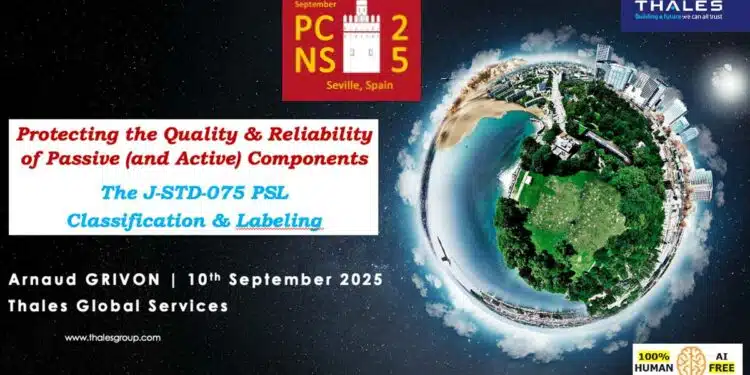The paper “Protecting the Quality & Reliability of Passive (and Active) Components: the J-STD-075 PSL Classification & Labeling” was presented by Arnaud Grivon, Thales Global Services, Meudon, France at the 5th PCNS Passive Components Networking Symposium 9-12th September 2025, Seville, Spain as paper No. 2.3.
Introduction
Passive components, while generally lower in cost than active components, are often the most numerous elements on a printed circuit board assembly (PCBA) and present unique challenges in terms of quality and reliability.
The transition to Pb-free soldering prompted by the RoHS directive exposed the thermal and process sensitivities of many passive components, such as capacitors, inductors, fuses, and connectors.
To address these sensitivities, standards like J-STD-020 (Moisture Sensitivity Level, MSL) and J-STD-075 (Process Sensitivity Level, PSL) have been developed. However, awareness and implementation of PSL classification remain limited, creating risks for high-reliability electronics.
Key Points
- Passive components are highly numerous on PCBAs and vary widely in form factors and construction.
- The shift to Pb-free soldering increased processing temperatures, exposing the thermal vulnerabilities of many passive components.
- Moisture Sensitivity Level (MSL) classification per J-STD-020 is widely used, but passive components lack clear failure criteria.
- Process Sensitivity Level (PSL) classification per J-STD-075 captures sensitivities to soldering, cleaning, and other PCBA processes.
- Many passive components are not adequately classified or labeled, leading to quality and reliability risks.
- Industry uptake of J-STD-075 remains low, despite its importance for preventing assembly failures and ensuring long-term reliability.
Extended Summary
In the early implementation of the RoHS directive and Pb-free soldering, many passive components were exposed to higher thermal stress and were found to be vulnerable to damage during reflow processes. Components such as aluminum capacitors, film capacitors, and tantalum capacitors, inductors, fuses, and crystals exhibited thermal and process sensitivities that limited the PCBA manufacturing window. Twenty years later, although materials and processes have improved, the problem persists, particularly because passive components are often not encapsulated like active devices and are more exposed to cleaning-induced risks.
Moisture-induced damage, such as the “popcorn effect,” was first recognized with non-hermetic plastic packages in the 1980s and 1990s. J-STD-020 (MSL classification) and J-STD-033 (handling and packing) were developed to mitigate these risks and are now standard practice worldwide. While MSL protocols were later extended to passive components, they provide no specific failure criteria for non-IC devices. As a result, some passive components carry MSL1 ratings without rigorous verification, leading to misleading classifications. Case studies of MnO2 tantalum capacitors and polymer resettable fuses demonstrate that unverified MSL1 ratings can result in cracking, delamination, or catastrophic failures.
In addition to moisture sensitivity, passive components frequently exhibit thermal and process vulnerabilities. J-STD-075, introduced in 2008 and revised in 2018, defines the Process Sensitivity Level (PSL) classification for both passive and solid-state components. It extends the MSL concept to sensitivities beyond moisture, including soldering, cleaning, and other PCBA processes. Components that cannot withstand three Pb-free reflow cycles or two wave soldering passes under J-STD-075 conditions must be classified with a PSL rating. However, many passive components, such as aluminum and film capacitors, still fail the base conditions and remain unlabeled, increasing the risk of assembly defects and field failures.
Cleaning sensitivities present further challenges. Passive components with open or delicate constructions—such as common-mode chokes, pressed-powder molded inductors, naked film capacitors, and wire-in-air fuses—can suffer adhesive degradation, corrosion, or internal damage when exposed to high-pressure cleaning or chemically aggressive agents. J-STD-075 encourages PSL labeling for cleaning sensitivities, although it does not define specific test protocols due to the wide variation in cleaning processes.
Finally, PSL classification also encompasses other process sensitivities such as vacuum picking and X-ray inspection for certain components. Despite the availability of standards, most passive component manufacturers have not fully implemented PSL labeling and classification. This lack of adoption reduces the ability of design and manufacturing teams to proactively manage risks, resulting in preventable quality and reliability issues.
Conclusion
Passive components, often overlooked in PCBA risk assessments, can pose significant quality and reliability challenges due to their moisture, thermal, and process sensitivities. While J-STD-020 and J-STD-075 provide comprehensive frameworks for managing these risks through MSL and PSL classifications, industry adoption—particularly of PSL labeling—remains insufficient. Greater awareness and implementation of these standards are critical to ensuring robust PCBA manufacturing and preventing costly field failures. This article calls for passive component manufacturers to embrace PSL classification as a key step toward improving electronic assembly reliability and supporting the digital continuity from design to manufacturing.































